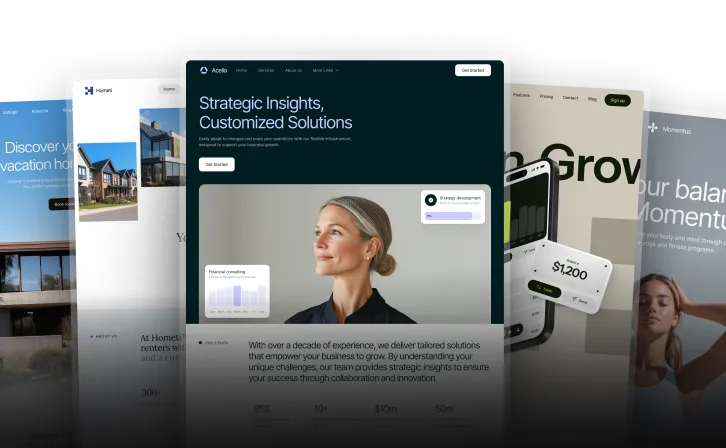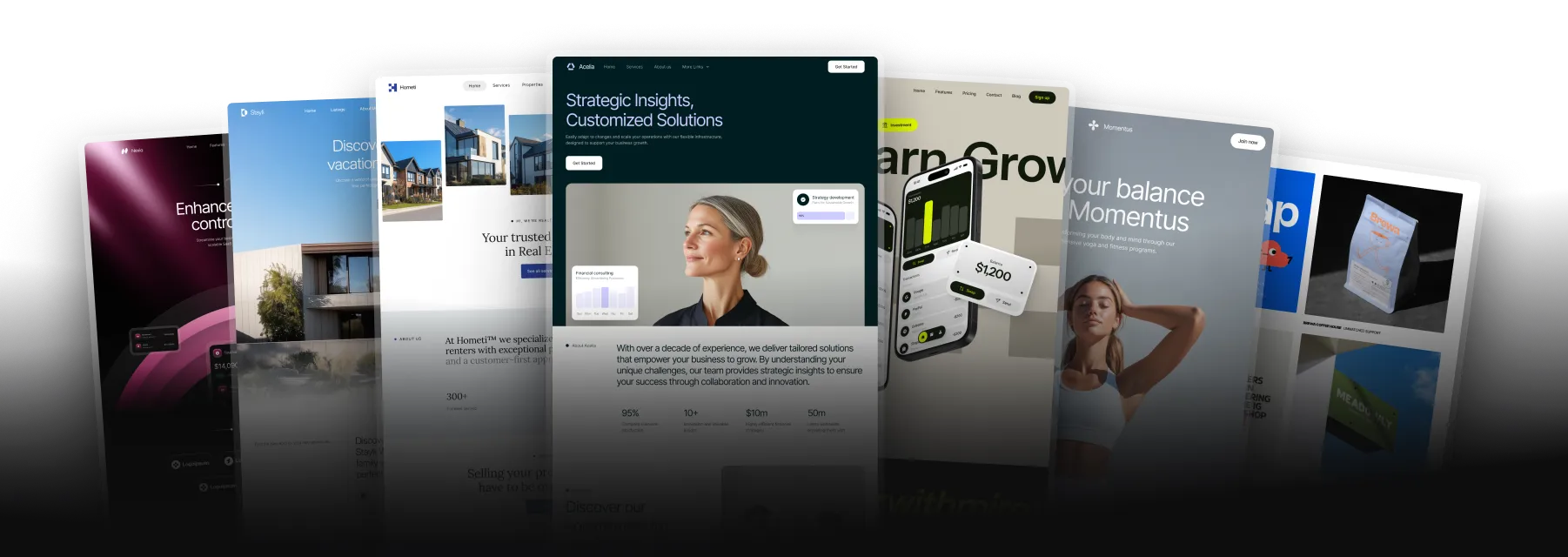Wordpress Alternative for 2025
Unlock all templates




After WordPress.org shut down in December 2024, millions of websites faced security risks, forcing businesses to search for better alternatives. Two standout platforms for 2025 are Webflow and Framer, offering modern tools for website creation without relying on outdated systems.
Key Highlights:
- Webflow: Advanced design capabilities, built-in e-commerce, and a powerful CMS. Ideal for businesses needing customization and scalability.
- Framer: Focuses on ease of use, quick prototyping, and interactive designs. Great for startups and design teams.
Quick Comparison:
| Feature | Webflow | Framer |
|---|---|---|
| Ease of Use | 6/10 (steeper learning curve) | 9/10 (intuitive interface) |
| E-commerce | Built-in, scalable plans | Limited options |
| Design Flexibility | High | High |
| Pricing | From $14/month | From $5/month |
| Best For | Content-heavy sites, e-commerce | Startups, interactive prototypes |
Both platforms cater to different needs, so your choice depends on your goals. Webflow is better for businesses with complex requirements, while Framer excels for design-focused projects.
Framer vs Webflow vs WordPress 2025: Which Website Builder Is The Best?

1. Webflow Platform Overview
Webflow is a platform that combines visual design tools with backend functionality. Its visual-first CMS allows users to create custom content structures and templates that can automatically generate pages.
Design Capabilities and Interface
Webflow features a drag-and-drop interface that produces clean, production-ready code. It supports advanced interaction design, enabling users to add scroll-based effects and multi-step animations to boost user engagement.
"Webflow has the power of custom coded web development but the accessibility of a visual interface. It's intuitive in a way that other platforms simply are not." - Marcus Jones, COO
Responsive Design Framework
Webflow's responsive design tools include a detailed breakpoint system. Designers can adjust layouts for various screen sizes using fluid grids and flexible sizing options, ensuring websites look great on any device.
Pricing Structure
Webflow offers several pricing options to meet different business needs:
| Plan Type | Monthly Cost* | Key Features |
|---|---|---|
| Site Plans | $14 - $39 | CMS features, custom domains |
| E-commerce | $29 - $212 | 500–15,000 items, varying transaction fees |
| Enterprise | Custom | Advanced security, dedicated support |
*Prices are based on annual billing
Performance and Security
Webflow ensures fast global loading times and strong security. For example, Temlis, a provider of premium templates, uses Webflow to create templates priced between $79 and $129. These templates cater to industries like SaaS, finance, and wellness, showcasing the platform's versatility.
E-commerce Capabilities
Webflow's e-commerce plans are designed to accommodate businesses of different sizes:
- Standard Plan: Supports 500 items, includes a 2% transaction fee, and costs $29/month.
- Plus Plan: Handles 5,000 items with no transaction fees at $74/month.
- Advanced Plan: Manages up to 15,000 items with no transaction fees at $212/month.
Webflow provides a flexible solution for businesses looking to move away from WordPress, offering both design customization and scalable e-commerce features. Next, we’ll explore Framer’s platform for a broader comparison.
sbb-itb-fdf3c56
2. Framer Platform Overview
Framer has become a standout no-code platform, blending visual design tools with advanced prototyping features. Its focus on intuitive controls and real-time collaboration has made it a go-to choice for design teams.
Design Interface and Capabilities
Framer’s drag-and-drop interface allows users to craft intricate layouts and detailed prototypes, complete with smooth animations and transitions.
"Framer excels in responsive design by displaying all breakpoints side by side, simplifying the process of designing for multiple devices." - Teodor Iliev, Founder of Wize Templates
Responsive Design Tools
One of Framer’s key features is its responsive design system. Designers can view and adjust layouts for different screen sizes side by side, making it easier and faster to create designs for various devices compared to older platforms.
Pricing Structure
Framer provides several pricing plans to suit different business needs:
| Plan Type | Monthly Cost | Key Features |
|---|---|---|
| Mini | $5 | Basic landing pages, single domain |
| Basic | $15 | Password protection, increased bandwidth |
| Pro | $30 | 10,000 pages, 100 GB bandwidth |
| Startup | $75 | Project permissions, advanced drafts |
| Scaleup | $200 | Enterprise-grade resources |
Integration and Collaboration
Framer works seamlessly with tools like Sketch and Figma, which ensures a smooth transition between platforms. Its real-time collaboration feature allows team members to work on the same project simultaneously, boosting efficiency and communication.
Performance Success Cases
A tech startup using Framer reported a 30% faster stakeholder approval process. By utilizing Framer’s high-fidelity prototypes with realistic interactions and animations, they were able to streamline the design review process significantly.
"Framer stands out with its superior interactive design capabilities, enabling users to create prototypes that closely mimic the end product." - Hannah Clark, Reviewer, The Product Manager
Content Management System
Framer’s CMS tools are designed for simplicity and modern web projects. While not as feature-heavy as traditional platforms, they’re ideal for startups and design-focused businesses that prioritize sleek visual presentation over complex content management. This makes Framer a solid alternative to WordPress for those looking for a more streamlined approach.
Next, we’ll dive into the strengths and weaknesses of both platforms.
Comparing Webflow and Framer: Picking the Right WordPress Alternative
When deciding between Webflow and Framer, it’s essential to weigh their strengths and limitations. Both platforms shine in different areas, making the choice largely dependent on your specific needs.
Design and User Experience
Webflow is known for its advanced design tools, but it comes with a steeper learning curve, earning a 6/10 for beginner-friendliness. Its visual-first approach allows for extensive customization, making it a go-to for design-focused teams.
Framer, on the other hand, scores higher on ease of use with a 9/10 rating. Its intuitive interface is ideal for quick prototyping and interactive designs, particularly for those already familiar with tools like Figma.
Industry-Specific Strengths
Webflow Benefits
- Advanced frontend design tools
- Built-in e-commerce features for small to medium businesses
- A robust CMS for content-heavy sites
- Visual development tools that reduce the need for developers
Webflow Drawbacks
- Challenges with scaling for larger SaaS projects
- Complex features sometimes require custom coding
- Costs increase as project demands grow
- Less backend flexibility compared to WordPress
Framer Benefits
- Excellent for prototyping
- Highly user-friendly for designers
- Prioritizes interactive experiences
Framer Drawbacks
- Limited e-commerce options
- Weak multilingual support
- Advanced features come with higher costs
- A learning curve for more complex functionalities
Feature Comparison
| Feature | Webflow | Framer |
|---|---|---|
| Ease of Use (Beginners) | 6/10 | 9/10 |
| Design Flexibility | High | High |
| E-commerce Capabilities | Built-in | Limited |
| Learning Curve | Steep | Moderate |
| Scalability | Medium | Limited |
| Custom Code Requirements | Moderate | Low |
Expert Insights
"Webflow offers a highly sophisticated platform with extensive capabilities, but this comes with a steep learning curve."
– SegmentUI
Temlis, a template marketplace, offers solutions for both platforms. Templates are priced between $49 and $129 and cater to industries like SaaS, wellness, and e-commerce.
Cost Considerations
Both Webflow and Framer provide pricing models that adapt as your project grows, making them competitive options.
Performance and Scalability
Webflow powers over 368,000 websites, showcasing its reliability for small to medium-sized businesses. However, larger organizations should carefully evaluate scalability needs, as neither platform matches WordPress’s extensive plugin ecosystem.
"Framer is a great choice for businesses seeking a unique and highly customized shopping experience."
– Harish Malhi, Framer Developer
Ultimately, the right choice depends on your business goals and technical expertise.
Which Platform Fits Your Needs
Choosing the right platform depends heavily on your industry and specific needs. Here's a guide to help you decide:
For SaaS Companies
Go with Webflow if you need:
- Advanced customization for showcasing products
- A powerful CMS to manage your content
- Full control over custom code implementation
Opt for Framer if you prioritize:
- Quick prototyping
- Interactive and dynamic designs
- Fast loading speeds (rated 9/10 for performance)
E-commerce businesses, on the other hand, should focus on balancing design flexibility with inventory and checkout features.
For E-commerce Businesses
Choose Webflow when:
- You're managing up to 500 products (Standard plan starts at $29/month)
- You want complete control over the checkout process
- Custom shipping rules are a must
"Webflow allows us to create a stunning and unique eCommerce site with almost anything: animations, effects, and a full responsive layout without having to dive deep into the code." - E-commerce designer Maximilian Müsgens
Pick Framer if:
- Shopify integration is critical for managing inventory
- Faster product page load times are a priority
- You need a platform that scales easily with a large product catalog
For service-based industries like wellness, design and SEO optimization can make all the difference.
For Wellness Businesses
"Webflow offers unparalleled design flexibility and SEO optimization options, making it the best decision for health and wellness businesses." - Web consultant Hayden Anderson
If you're in the wellness industry and looking for specialized templates, Temlis provides tailored options like Harmoni ($79) and Serenium ($79). Both templates are fully customizable and designed specifically for fitness and wellness services.
A real-world example: A yoga studio in New York City transitioned to Webflow in June 2023. Within three months, they saw a 50% boost in website traffic and a 30% increase in class bookings, thanks to better design and SEO features.
Related Blog Posts
Recommended posts
Unlock all templates







